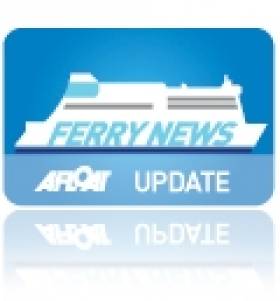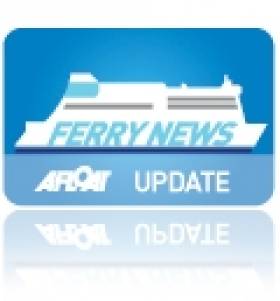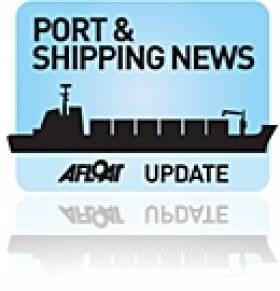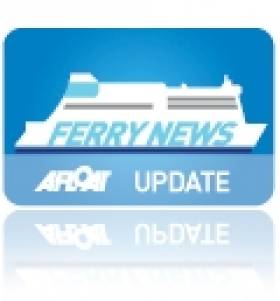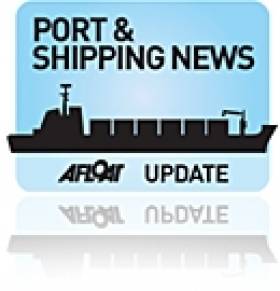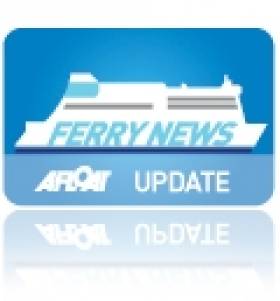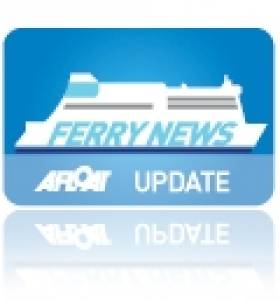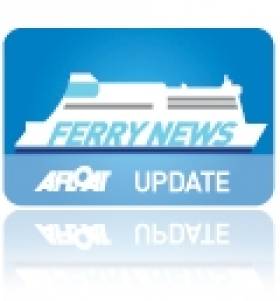Displaying items by tag: Mersey Ferries
Operator of the Famous Mersey Ferry Sees River Cruise Figures Boost for Last Year
On Merseyside, ticket sales for the River Explorer Cruise have passed those of pre-pandemic levels during the summer of 2023, the ferry operator of the popular excursions have unveiled.
During the period, sales at the north-west England tourist attraction run by Mersey Ferries have jumped by more than 12 per cent.
The 50 minute tours on board the world famous ferry are based from the terminals of Liverpool Gerry Marsden or Seacombe on the Wirral side of the Mersey.
Excursionists on the cruise which the MV Snowdrop built in 1960, has been touring the Mersey for many years which passes the iconic landmarks across Liverpool city centre and those on the Wirral Peninsula.
More InsiderMedia has on the increased demand for the sight-seeing service.
As part of the ferry company's history, Afloat highlights is that the The Beatles performed four times on board The Royal Iris at The Cavern Club’s famous Riverboat Shuffle Cruises in 1961 & 1962.
#BattleofAtlantic- For five days, Liverpool is to host the 70th and final UK anniversary commemoration of the Battle of the Atlantic between Friday 24 to Tuesday 28 May.
In total there are 25 naval ships calling at the Liverpool Cruise Terminal and at Albert and Canning Docks, with several of these vessels made open to visitors. Naval vessels from the UK, Canada, Germany, Italy, Russia and the US will represent both sides of the conflict which ran the entire length of the Second World War, from 1939 to 1945.
On the final day of the event, Tuesday 28 May, all visiting ships will depart in a coordinated parade on the Mersey. To take part in the maritime spectacle, Mersey Ferries will be joining the flotilla and will follow the ships as they head out of the Mersey. On board the excursion cruise, a Blue Badge Guide will provide live commentary.
Mersey Ferries are to provide two ferries for the Farewell Cruise. The following are departure times for the farewell cruises are as follows: Departing Liverpool at 1.00pm and the other cruises are scheduled to depart Seacombe also 1.00pm and from Woodside at 1.15pm.
Ticket price for the Farewell Cruise are £25.00 per person. Each cruise is approximately 3-4 hours (duration time may vary).
In addition Mersey Ferries are to offer guaranteed parking spaces at both Seacombe and Woodside with a charge of £5.00 per car (noting spaces are limited).
For further details and how to book online visit: www.merseyferries.co.uk/content/Cruises/Cruisedates.aspx
#CanalCruises – Operators of the famous ferry cross the Mersey will again be launching Manchester Ship Canal Cruises starting in early April, writes Jehan Ashmore.
Treat yourself to the leisurely 6 hour return cruise along the 35 mile canal. To wet your appetite click HERE for a taster of the passage by viewing the Mersey Ferries TV Advert.
The canal cruise can start at Salford Quays (M50 3AH); or at the opposite end of the route from either our Seacombe (Wirral CH44 6QY) or Liverpool (L3 1DP) terminals.
Take in the spectacular scenery whilst a live commentary tells the story of how this magnificent waterway shaped the city of Manchester and the North West of England.
Over the passage of time, Runcorn (near the start of the canal) and Salford Docks where locations for the discharging of Guinness.
The 'black-stuff' was transported across the Irish Sea by the last of the stout-tankers The Lady Patricia and Miranda Guinness.
The trade ceased two decades ago in 1993 following the introduction of road-stout tankers that take the ferry instead.
Another Irish Sea route connection to Dublin Port had up untill recently operated two container vessels from Liverpool, however one of these ships, Coastal Deniz has shifted to a newly upgraded domestic service.
The service which is operated by this larger container vessel is running between Liverpool's Seaforth Container and the Irlam Container Terminal, near Trafford Park in Manchester.
Due to a marked increase in trade along the canal from customers among them Kelloggs, a trail-run period in running Coastal Deniz during January had proved successfull, leading to the transfer of the 260 TEU capacity vessel operated by Peel Ports.
The deployment of the 1991 built vessel to the canal route will move in the region 20,000 containers during 2013. The service between Liverpool to Irlam will operate four times weekly. For more WorldCargoNews.com has a report.
Once you've finished your day of cruising, Mersey Ferries we'll return to your point of departure by dedicated bus transfer.
Tickets are available from only £36 per person. Advance booking is necessary. To book or for more information call 0151 330 1444 or visit this LINK.
Ferry Cruises to Mark HMS Illustrious Visit to Liverpool
#SightseeingCruise- Special river explorer cruises operated by Mersey Ferries are to run this weekend to mark the visit of HMS Illustrious (R06) to Liverpool.
Onboard the river cruises this weekend 16-17 February, between 11am and 4pm (including 4pm cruise), Blue Badge Guides will be giving passengers live commentaries about HMS Illustrious and the aviation history of the Royal Navy.
For further details visit: www.merseyferries.co.uk/content/Cruises/Cruisedates.aspx
Ports & Shipping Review- Research Vessel Returns, Record Cruise Season, Fast & Slow Ferry Refits, Port Upgrade and Riverferry's Fate?
#ShippingREVIEW- Over the last fortnight, Jehan Ashmore has reported from the shipping scene, where the Geological Survey of Ireland (GSI) research vessel Keary, returned to Dun Laoghaire Harbour following modification work at Arklow Marine Services.
A record total of 64 cruiseships are to call to Cork Harbour, making the 2013 season the busiest year to date and includes six maiden calls and two cruiseships will make overnight calls.
The New Year brought changes at Ardmore Shipping, where new promotions have been made for personnel at senior management level.
Not a single fast ferry is to be found operating on the Irish Sea, not to bad weather, but for the brief absence of Irish Ferries Jonathan Swift, currently in refit, from year-round Dublin-Holyhead service.
One of Stena Line's Dublin Port-Holyhead route ships, Stena Nordica is on relief duty, covering for Stena Europe between Rosslare-Fishguard. In place of the 'Nordica' Dublin sailings, the chartered Finnarrow is maintaining sailings to Holyhead.
A major upgrade of the Scottish ferryport of Cairnryan, on Loch Ryan, has begun to improve operations for P&O Ferries short-sea route to Larne.
According to the Port of Cork, a total of 9.05 million tonnes in trade traffic levels was reached at the end of 2012, not since 2008, has the port surpassed 9m tonnes.
Royal Daffodil, one of the famous Mersey Ferries fleet due to be withdrawn, has been discussed with the National Waterways Museum, but no decision has been made as of yet.
The efforts of Cruise Belfast has paid off as the 2013 cruise season is to be a record year with close to 60 calls bringing more than 100,000 visitors to Belfast Harbour.
Famous Mersey Ferry to be Withdrawn Awaits Uncertain Future
#MerseyFerry- Royal Daffodil, as previously reported on Afloat.ie, is due to be withdrawn from the Mersey Ferries fleet. She is to lay-up at the Duke Street Basin in Birkenhead, from the end of the month on shore power, following dry docking, reports Jehan Ashmore.
The veteran vessel, now in her 51st year, is currently berthed at the nearby Cammell Laird dry-dock facility where a hull inspection is to be carried out by a MCA Surveyor. Her running mates, Royal Iris of the Mersey and Snowdrop, a pair of older sisters, continue to serve routes across the Mersey linking Liverpool to the Wirral Peninsula.
Operator Mersey Ferries claim the reason for the planned reduced fleet, follows declining passengers and significant losses incurred by the company.
According to Mersey Ferries, discussions have been held with the National Waterways Museum, with regards to Royal Daffodil, but no decision has been made as of yet.
Ports & Shipping Review: Fate of WWI Warship Secured, Ferry Festive Season, HSS Coincides Celebrating 50th, Mersey Ferry Reduction and Proposed Cross-Border Service
#PORTS & SHIPPING REVIEW - Over the last fortnight of 2012, Jehan Ashmore has reported from the shipping scene where a £1m restoration grant is to be spent on the WWI battlecruiser HMS Caroline.
The festive season saw the return of Stena Line HSS fast-craft Dun Laoghaire-Holyhead sailings which coincided with the Swedish owned ferry giant celebrating 50 years in service.
Across Dublin Bay rivals Irish Ferries added capacity to cope with expected demand by transferring Isle of Inishmore from St. Georges Channel service and onto the Dublin-Holyhead route.
Also running seasonal services to from Dublin Port was the Isle of Man Steam Packet Company whose ro-pax Ben-My-Chree provided two weekend round trips either side of the Christmas festivities.
One of the famous 'ferry cross the Mersey' river ferries linking Liverpool to the Wirral Peninsula is to be withdrawn in January 2013 by operator Mersey Ferries due to reduced traffic and heavy losses.
On a more positive note, albeit on other side of the Irish Sea, there are proposals to start a new cross-border car-ferry service across Carlingford Lough between Greenore, Co. Louth and Greencastle Co. Down.
World Famous ‘Ferry Cross the Mersey’ Fleet Reduced
#MERSEY FERRY – One of three River Mersey ferries, the 50 year-old Royal Daffodil is to be withdrawn from service in January 2013. The ferry will be laid-up following declining passengers and significant losses incurred by Mersey Ferries (Merseytravel), writes Jehan Ashmore.
Cllr Liam Robinson, Chair of Merseytravel said, "We recognise the place the Ferries hold in Merseyside lore and culture, and that they are an essential part of our heritage. We are committed to keeping them in operation".
He added, "But we also have to recognise that times have changed. Passenger numbers have fallen, to around 650,000 annually, and an operating deficit of £1m per annum cannot be sustained".
As previously reported on Afloat.ie, Royal Daffodil operates 'party' cruises, in which the last such commercial sailing in 2012 was carried out last weekend, followed by a staff Christmas party cruise.
The ferry launched as Overchurch in 1962, is to leave service also due to engine-problems and limited external deck space, which is considered less suitable than her fleetmates serving the cross-river commuter service, particularly at peak times.
The younger 1960 built fleetmates Snowdrop (ex Woodchurch) and Royal Iris of the Mersey, also commissioned for Mersey ferry service, will in 2013 continue operating commuter shuttle services and running Manchester Ship Canal cruises.
Incidentally 'Royal Iris' which under her original name Mountwood, was chartered to serve as a tender for the US Navy aircraft-carrier USS John F. Kennedy while at anchorage off Dun Laoghaire Harbour in 1996. She carried US Navy crew and thousands of visitors back and forth to the harbour's Carlisle Pier, then in its final year as a ferry terminal.
Have a Ferry Merry Cruise
#FESTIVE CRUISE – A Christmas Party Night Cruise with resident DJ playing your favourites from the 70's to the present day will be a night out with a difference, as you set sail onboard Mersey Ferries.
The Royal Daffodil, which is often used for party nights with its dance floors and large inside saloons will too during the Christmas Cruise cater for office parties, groups of friends or even families. So if you fancy a giggle get out your favourite clothes from your favourite era and you could win a bottle of champagne, there are prizes for best male and female costumes.
The cruise on 15th December departs Liverpool's Pier Head at 8.30pm and Seacombe at 8.45pm and lasts approximately 3½ hours. Tickets are £16.00 per person and can be purchased at the terminal of Mersey Ferries or Tel: 0151 330 1444 or online by visiting this LINK
Take the Famous Mersey Ferry and Spot that ‘Liverbird’
#'BIRD' FERRY- The famous Mersey ferry is to run 'Liverbird' Bird Watching & Wildlife Cruise this coming Saturday 13th October.
Mersey Ferries have teamed up once again this year with the RSPB and National Museums Liverpool to get you closer to nature. The RSPB will be on hand during the cruise to provide a running commentary, plus experts will be available to answer any of your questions as we journey on the River Mersey and out into the bay.
The cruise is for all, be it the family, the experienced bird watcher or novice. As this is the final cruise of the season there will be expertise from those who have knowledge of wildlife in wetland areas, as well as to helping children on board make bird feeders!
With previous sightings including long-tailed skuas, peregrine falcons, osprey and Atlantic grey seals, there should be all sorts of wildlife-so get prepared for some spotting!
The cruise departs Seacombe at 11.00am, Pier Head at 11.10am and Woodside 11.20am and lasts approximately 3 hours. Ticket prices are £14.00 for adults and £7.00 for children (3-15yrs) and advance booking is necessary online or by clicking HERE or to Tel: 0151 330 1444




























